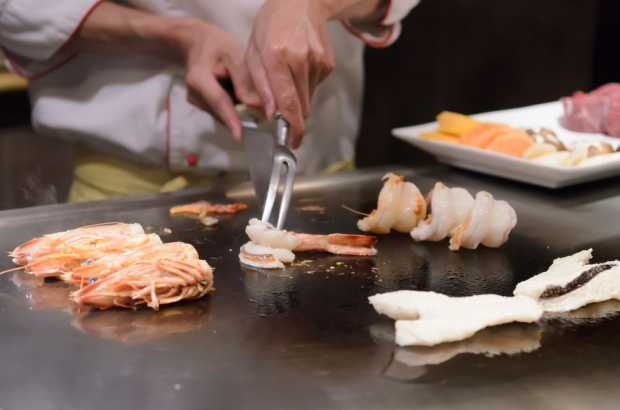Not a member yet? Sign Up!
Info
Please use real email address to activate your registration

Japan, the Land of the Rising Sun, is a country with the highest life expectancy. The Japanese always believe that food from a clean environment is nutritious, tasty, and good for health.

The country’s achievements in commerce, industry and technology do not make the Japanese forget about their traditional values, especially in the culinary world. Japan’s ability to preserve its food culture is exemplary.
One way to introduce Japanese food and culinary diversity is through a TV program named The Iron Chef.
The Iron Chef
The Iron Chef was a legendary television program aired by Fuji Television from 1993 to 1999. It combined the excitement of a one on one cooking competition in a kitchen stadium. By designing such competition, the Iron Chef introduced the world to Japanese cooking techniques, exotic ingredients and incomparable presentation.
Including its local adaptation, the Iron Chef has been shown in 78 countries, with the Indonesia version airs through Trans TV beginning on February 2013.
Eventually, people can experience the Iron Chef sensation not only through television. Some of the iron chefs opened their own restaurants or worked with fine establishments to feature their creations.

Dapur Iron Chef
Starting on 26 January until 31 March 2013, Dapur Iron Chef, or the Iron Chef Kitchen opened in Plaza Senayan, Jakarta, offering specific menus from five leading restaurants in Japan.
Dapur Iron Chef is part of Cool Japan, a program initiated by Japan’s Ministry of Economy, Trade and Industry. Cool Japan promotes the nation’s creativity-based industries, including animation, fashion and food, both at home and overseas.
Essentially, Dapur Iron Chef is a market test for particular Japanese food businesses where for a limited time Jakarta food lovers have a chance to savor meticulously prepared cuisines from Spoon Bread, Dai-Tokyo Sakaba, Menya Iroha, Aloha Terrace, and Sagami.

On Friday evening, 1 March 2013, along with several food bloggers I was invited by Media Tree for food tasting at Dapur Iron Chef, spoiling our taste buds with signature dishes from Aloha Terrace and Sagami Restaurant.
Aloha Terrace
Owned by Pearl Marketing Solutions Co. Ltd., Aloha Terrace is a Japanese restaurant that combines Japanese, Hawaiian and Indonesian culinary cultures and termed their specialty Hawaiian Barbeque.
Following Dapur Iron Chef in Plaza Senayan, its first outtlet will open in April on Jalan Boulevard, Bintaro Jaya.
Mr. Asano, on behalf of Aloha Terrace, described that by processing and offering halal and delectable cuisines, the eatery is presenting a new concept for culinary lovers in Indonesia.
During the food tasting, this restaurant served three dishes:

Mochiko Chicken with Hot Chili.
The dish, consisting of three pieces of boneless chicken has a soft and crunchy textures with savory flavor.

Loco Moco Bowl.
The bowl consisits of seasoned beef burger served with rice draped with sunny-side up egg, and garnished with a slice of fried pineapple, lettuce and tomato. This dish is sweet, sour and savory, a perfect blend of sauces and spices. Loco Moco has a large enough portion and can be relished alone or shared with friends for lunch.

Hawaiian Garlic Shrimp.
Processed with flour, garlic and other spices, it is a fried shrimp dish. It is savory with garlic taste distinctive in each shrimp.
Sagami
After enjoying a 3-course menu from Aloha Terrace, we also tried food from Sagami Restaurant. Mr. Satowaki who represented Sagami explained that the restaurant, owned by Sagami Chain Co. Ltd., was founded in Nagoya in 1974.
The menu selections mostly have soba (buck wheat noodle) as the main ingredient. Soba is special in that it is low in calorie and good for the skin; hence, it is a healthy food.
Sagami offered four dishes for the food tasting:
Soba Cha
Tea made from a mixture of buckwheat and green tea. Soba Cha is good whether served warm or cold.

Tebasaki (fried chicken wings)
Prepared with a variety of ingredients such as: flour, salt, soy sauce, vegetable oil and a sprinkle of sesame seeds. I can taste the seasoning up to the last piece of the starchy chicken. Tebasaki is appropriate for any meal of the day.

Curry Chicken Soba
A mix of curry sauce, radish chunks, diced chicken, chopped onion and thinly sliced kamaboko (fish cake). Unlike Indian curry, Japanese curry has a softer texture, and tastes neither spicy nor savory.

Mt. Fuji Beef Soba
A bowl of teriyaki marinated beef with Japanese radish, spring onion and soba noodles. Decorated with kamaboko for an extra taste it is shaped in the form of a mountain.
Mr. Satowaki suggested shoyu broth as a condiment for the food. Shoyu broth is a typical Japanese broth enhanced with fish stock. The fish, a type of tuna, was traditionally smoked for one day and then dried between 6-12 months. Once smoked and dried the fish is then shredded and made into fish stock. Shoyu, Japanese soya sauce, is added in the cooking process.
Mission Possible
Dapur Iron Chef, in my opinion, successfully introduced Japanese cuisines from different perspectives. It is exciting to learn that Japanese food is not limited to sushi, tempura, shabu-shabu, and udon, familiar to many Indonesians.
Japan, the world's oldest independent country, has many to offer not only its healthy, tasty and nutritious food but also its culinary culture.

Through the food tasting at Dapur Iron Chef, I hope to enrich my blog posts with knowledge on the culture, the process and the story behind Japanese cuisines.
-----------------------------------
Text: Dian Anggraini.
Images: Artit Thongchuea, Skyearth, Sanupot/Shutterstock; Iron Chef Indonesia, Dimas Wibowo/Omar Niode Foundation